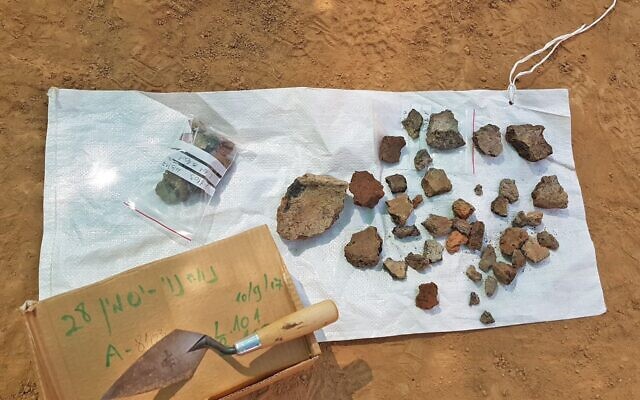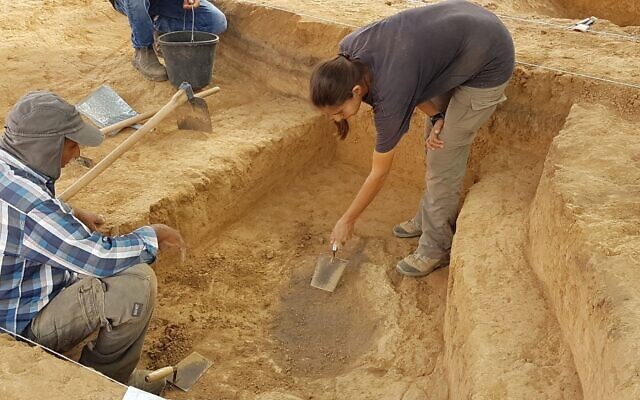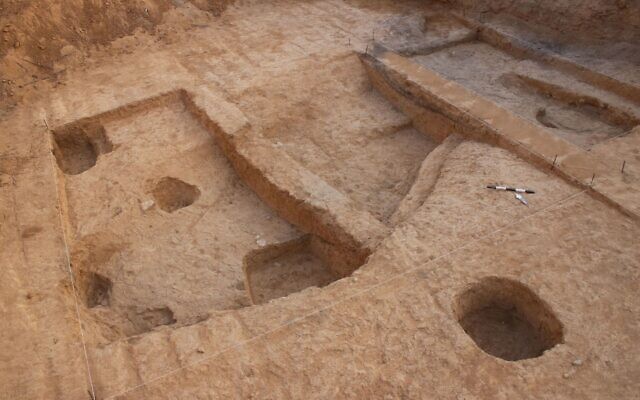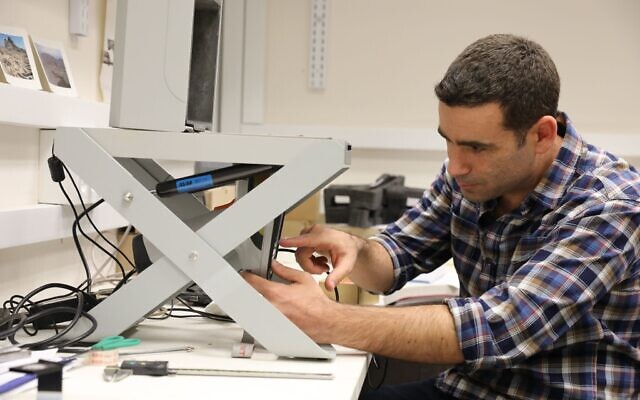A new archaeological study shows that even some 6,500 years ago, Israel was already a start-up nation — complete with a metallurgy R&D hub in Beersheba. Salvage excavations in the Negev Desert capital in 2017 revealed 6,500-year-old copper smelting workshops using the earliest-known evidence of furnaces instead of small portable crucibles for metallurgy.
“This is the high tech of the period, there was no more sophisticated technology,” said Tel Aviv University Prof. Erez Ben-Yosef. The movement from crucible to furnace represents cutting-edge technology, said Ben-Yosef.
Metallurgy emerged in the Southern Levant during the second half of the 5th millennium BCE. According to Ben-Yosef, the Beersheba discovery indicates a technological evolution from an earlier method of smelting ore, which used small pottery crucibles, to these newly uncovered, larger in-ground furnaces.
The innovation allowed for a two-step smelting process in industrialized workshops uncovered in several Beersheba-area settlements. These workshops, he said, were manned by highly specialized craftsmen that produced pure copper ingots and some ceremonial objects.
“There is no doubt that ancient Beersheba played an important role in advancing the global metal revolution and that in the fifth millennium BCE the city was a technological powerhouse for this whole region,” he said in a Tel Aviv University press release.
The findings were published in the study “Firing up the furnace: New insights on metallurgical practices in the Chalcolithic Southern Levant from a recently discovered copper-smelting workshop at Horvat Beter (Israel),” which appeared in the scientific Journal of Archaeological Science: Reports.
The Horvat Beter site was excavated ahead of a neighborhood expansion in Beersheba. “The surprising finds include a small workshop for smelting copper with shards of a furnace – a small installation made of tin in which copper ore was smelted — as well as a lot of copper slag,” said Talia Abulafia, director of the excavation on behalf of the Israel Antiquities Authority.

Talia Abulafia, Excavation Director, Israel Antiquities Authority. (Emil Aladjem/Israel Antiquities Authority)
The Horvat Beter settlement is identified with the Chalcolithic period’s Ghassulian culture, which is known for its fine craftsmanship. There, raw copper ore, mined 100 kilometers away in Jordan’s mineral-rich Wadi Faynan, was refined in what Ben-Yosef calls a “magical” process.
“It was not that they threw this green mineral into the fire and woke up and got copper,” Ben-Yosef told The Times of Israel. Production required sophisticated knowledge of temperature control, mineral mixture and many other parameters. “The end result was like magic — you take a rock and turn it into this shiny wonderful material,” he said.
The study included elemental analysis of ceramics and slag which was primarily conducted by a portable X-ray fluorescence instrument, according to the article. The team analyzed 14 crucible fragments, 18 presumed-furnace fragments and 26 pieces of slag.

Copper slag found at the Neveh Noy excavation in Beersheba. (Anat Rasiuk/Israel Antiquities Authority)
“Our results demonstrate clearly that the metallurgical workshop at Horvat Beter was dedicated only to the smelting of copper,” write the authors. The study was conducted by Ben-Yosef, Dana Ackerfeld and Omri Yagel of the Jacob M. Alkow Department of Archeology and Ancient Near Eastern Civilizations at Tel Aviv University, in conjunction with the Israel Antiquities Authority’s Abulafia, Dr. Yael Abadi-Reiss and Dmitry Yegorov, and Dr. Yehudit Harlavan of the Geological Survey of Israel.
A magician never tells
Copper beads and the mineral’s use as a pigment preceded its use as a purified metal — the making of which was “magic.” Ben-Yosef believes the Beersheba craftsmen operated in guild-like clusters that carefully guarded their workshops’ secrets. He believes the craftsmen were an elite segment of the fledgling societal hierarchy.
There was variety among the different workshops in the area: “Differing sizes of crucibles indicates competition among workshops, exploration of technology,” write the authors. According to the TAU press release, “A chemical analysis of remnants indicates that every workshop had its own special ‘recipe,’ which it did not share with its competitors.”
The craftsmen traded with people who lived in the area of the copper mines 100 kilometers (62 miles) away in Jordan for the ore. After purification into ingots, the metal was then likely taken elsewhere to be molded into ceremonial objects.

6,500-year-old copper smelting operation at the Neveh Noy neighborhood of Beersheba. (Anat Rasiuk/Israel Antiquities Authority)
Ben-Yosef said the technological innovation of the furnace was based on the craftsmen’s early scientific work and expertise in copper smelting — which he deeply respects. For the past several summers, graduate students have attempted to use reconstructed Beersheba furnaces to replicate the ancient copper production.
In June, “between the coronavirus lockdowns,” said Ben-Yosef, the team was finally able after several summers’ attempts to produce copper using the Beersheba methodologies during a graduate student seminar.

Tel Aviv University experiment to re-enact 6,500-year-old copper smelting technology from Beersheba, June 25, 2020. (Central Timna Valley Project)
Ben-Yosef marveled at the Beersheba craftsmen’s ability to produce the metal without the use of chemistry or modern measuring tools. He said that they used “other clues,” such as a change in flame colors for the perfect temperature.
“What we do in our lab in Tel Aviv is to get a high-resolution picture of the changes through time, how they happened, how we have new ideas, all of which is still relevant today,” he said. He said his lab invests a lot of resources into replicating ancient methodologies.
“You read the [research] articles and you think you know, but in this real-time experience you discover that even when you think you know everything, it’s very different to do,” he said, adding that metallurgy was the most demanding technology of the period.
Curiosity may have killed the cat, but it gave us good copper
Counter to the common view that technological innovation is a matter of finding a need and filling it, the Beersheba pure copper ingots as well as the objects made from them were unlikely to have been used in a utilitarian manner, he said. The pure metal was too soft and too rare to have been used in everyday life to merely put food on the table.
Even pure copper items that look “utilitarian” were likely not. In the study, researchers examined pure copper axes and adzes for wear, but their clean edges indicate they were never used.
Ben-Yosef believes that the pristine “utilitarian” objects were imitations of the stone tools that were still commonly used during this era. The knock-offs would have been used in ceremonies or for exhibit as social status symbols. (The most famous examples of these ceremonial objects were found in 1960, when a large hoard of some 400 metal objects was discovered in the Judean Desert’s Nahal Mishmar Cave of the Treasure, which is on permanent display at Jerusalem’s Israel Museum.)

6,500-year-old copper smelting operation at the Neveh Noy neighborhood of Beersheba. (Talia Abulafia/Israel Antiquities Authority)
“I find it quite fascinating because people always think innovation comes with necessity — to create tools for farming or weapons to win a war — but here we have technological inventions related to human curiosity,” he said.
The notion that “some societies allowed people to play with materials and find new stuff without the pressure of putting food on the table” creates a more nuanced picture of these ancient societies, with resonance well beyond the scientific copper smelting study.
“The people of the past are not so different than the modern era and we see it in the technological evolution of metal,” said Ben-Yosef.
Related posts:
Views: 0
 RSS Feed
RSS Feed

















 October 4th, 2020
October 4th, 2020  Awake Goy
Awake Goy 
 Posted in
Posted in  Tags:
Tags: 
















